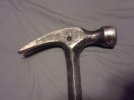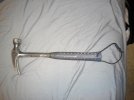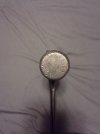There's been discussions about a lot more in this forum than just axes and their brethren. There's also been talk about shovels, pitchforks, rakes, and a number of other outside implements. So with that thought in mind I'd like to bring up another topic; hammers. More specifically, hammers used in construction work, be they framing hammers, drilling hammers, or even sledge hammers. Everybody has a favorite type that they turn to most when they need to pound away at something. So let's see some pictures, hear some stories, and discuss this matter.
My favorite hammer is my Estwing framing hammer (technically a finishing hammer since it didn't have a milled face) that I got at the pawn shop for real cheap. Despite seeing a ton of use by the previous owner(s) it's still going strong for me, and I don't see it breaking anytime soon. This thing is incredible when a nail has to be tended to, since there's so much more striking power compared to a regular 16 oz. hammer.
My favorite hammer is my Estwing framing hammer (technically a finishing hammer since it didn't have a milled face) that I got at the pawn shop for real cheap. Despite seeing a ton of use by the previous owner(s) it's still going strong for me, and I don't see it breaking anytime soon. This thing is incredible when a nail has to be tended to, since there's so much more striking power compared to a regular 16 oz. hammer.













